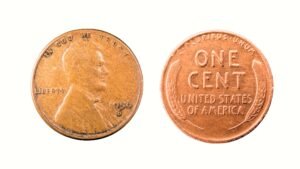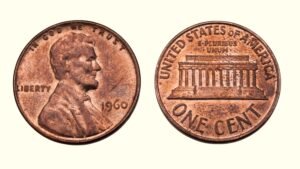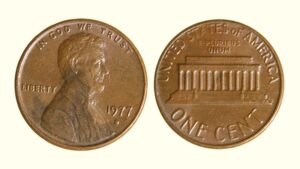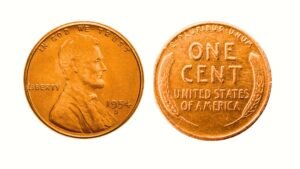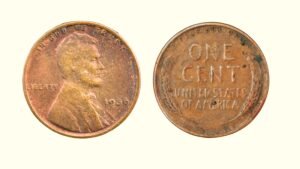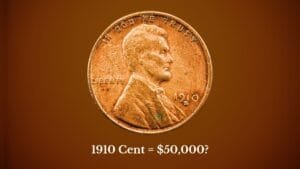Got a 1937 Lincoln penny in your change jar? Don’t toss it just yet! Some of these old Lincoln cents are worth big bucks – we’re talking hundreds or even thousands of dollars, like the one sold for $23,675!
But how do you know if your 1937 copper cent is a winner? This guide will show you exactly what to look for. From rare mint marks to weird errors, we’ll cover all the valuable features that could make your 1937 penny a secret treasure!

The average value of a 1937 Lincoln penny in circulation ranges from $0.15 to $1, while the same coin in high-grade mint state or with proof finish or rare errors can fetch up to $20,000 or more!
1937 Lincoln Wheat Penny History
The 1937 Lincoln Penny is part of the iconic Lincoln Wheat Cent series, which was minted from 1909 to 1958. In 1937, the United States was recovering from the Great Depression under President Franklin D. Roosevelt’s New Deal policies.
The Lincoln Penny, designed by Victor D. Brenner, was in its 28th year of production in 1937. It was produced at three major facilities: Philadelphia, Denver, and San Francisco in substantial numbers.
The relatively high mintage indicates that 1937 pennies are quite common today. Nonetheless, well-preserved examples or those with rare features are still highly collectible today fetching extraordinary amounts from coin collectors.
| 1937 Lincoln Penny | Key Features |
| Coin Composition | Bronze (95% Copper, 5% Tin & Zinc) |
| Minting Location | Philadelphia, Denver & San Francisco |
| Year of Minting | 1937 |
| Face Value | One-cent |
| Weight | 3.11 grams |
| Diameter | 19.05 mm |
| Thickness | 1.52 mm |
| Designer | Victor David Brenner |
| Mint Marks | No Mint Mark (Philadelphia Mint) D-mint mark (Denver Mint) S-mint mark (San Francisco Mint) |
| Total Mintage | 394,109,320 |
How to Identify a 1937 Lincoln Cent (Design & Physical Features)
Before assessing your 1937 wheat penny value, make sure it’s a real vintage copper coin and not a counterfeit by verifying the following design elements and features:
1937 Lincoln Penny Obverse:

- A right-facing profile of Abraham Lincoln
- “IN GOD, WE TRUST” on the top
- The word “LIBERTY” to Lincoln’s left
- The mint date “1937” to the Lincoln’s right
- The mint mark “S” or “D” (if present) below the mint year
1937 Lincoln Penny Reverse:

- The denomination “ONE CENT” at the center
- Two wheat ears/stalks framing the denomination
- The words “E. PLURIBUS UNUM” written on the top, along the edge
- “UNITED STATES OF AMERICA” below the face value/denomination
1937 Penny Composition, Weight & Size
The 1937 Lincoln penny is composed of bronze alloy with 95% copper and 5% zinc. This traditional composition gives the small cent a distinctive weight of 3.11 grams and its iconic reddish-copper color.
This composition was finally replaced in 1982 when the United States Mint transitioned to the copper-plated Zinc coins.
As for the coin’s size, it has a diameter of 19.05 mm and a thickness of 1.52 mm with a uniform, non-reeded, smooth edge.
How Much Is a 1937 Penny Worth (5 Value Factors)
| Coin Grades | 1937 No Mint Mark Penny Value | 1937 D Penny Value | 1937 S Penny Value |
| Poor (0) to Extremely Fine (XF45) | Face Value to 30 cents | Face Value to 50 cents | Face Value to 50 cents |
| Almost Uncirculated (AU50) to Mint State (MS60) | 80 cents to $5 | 80 cents to $8 | $1 – $8 |
| Mint State (MS61 – MS64) | $10 – $20 | $8 – $20 | $10 – $25 |
| Mint State (MS65 – MS66+) | $15 – $60 | $15 – $65 | $20 – $70 |
| Mint State (MS67 – MS67+) | $90 – $1,140+ | $100 – $700+ | $175 – $1,560+ |
| Mint State (MS68 or Above) | $6,400 – $7,200 | $8,500 – $11,500+ | N/A |
There are 5 key factors that determine whether your old 1937 copper cent is just worth a few cents or some really big bucks:
1. Coin Grading and Condition
The value of your 1937 Lincoln penny coin heavily depends on its condition, which is professionally measured in grades ranging from PO-1 to MS-70. Higher grades mean a better condition, which increases the coin’s value.
For example, an MS68 red 1937 D penny sold for $11.500 in coin auction, but the same coin will only sell for $10-$30 if it’s graded MS65. That’s the difference coin grades can make on your 1937 penny coin value!

2. Coin Toning & Color
It may sound odd, but the color of your 1937 copper penny also plays a vital role in determining its value. While all new copper cents are red in color, they turn brown overtime due to toning and oxidation, impacting its overall worth. Let’s see how:
- Red (RD): Pennies with a bright, flawless copper-red luster like a new coin are graded red. These coins command the highest prices, often ranging from $15 to a few thousand dollars.
- Red and Brown (RB): RB-grade coins display a mixture of red and brown, indicating some oxidation. They’re valued lower than red coins but can still fetch $10 to $100 in high-grade mint state, depending on mint marks.
- Brown (BN): These pennies showcase a dark brown color often due to extreme oxidation. These coins are less desirable, but high-grade examples or those with errors can still fetch $1 to $15.
3. 1937 Lincoln Wheat Cent Mint Marks
The different mintage and mint marks of the 1937 Lincoln penny produced at different locations also significantly influences its value. This coin was struck in Philadelphia, Denver, and San Francisco. Here’s a detailed breakdown:
1937 No Mint Mark Penny Value (Mintage – 309,170,000)
The Philadelphia Mint produced over 309 million copper pennies in 1937, identified by the no mint mark. Most common of all, the average value of a circulated 1937 no mint mark penny is a few cents, but uncirculated coins in mint state can fetch $10 to $6,500 in MS60 to MS68 grades.
1937 D Wheat Penny Value (Mintage – 50,430,000)
All the 50 million plus 1937 pennies struck at the Denver Mint bear a D mint mark. Slightly rarer than the no mint mark pennies, a 1937 D penny is also worth a few cents in circulated state.
On the other hand, MS60-M64 examples range from $10 to $15 and MS65-MS7 grades are worth $15 to $650, with MS68 1937 D pennies reaching up to $11,500! In fact, an MS68-example once sold for an auction record price of $17,250 on Bowers & Merena auction!
1937 S Wheat Penny Value (Mintage – 34,500,000)

With a total of over 34.5 million coins, the San Francisco Mint produced the least 1937 wheat cents, identified by the S mint mark. While these pennies also sell for a few cents in average condition, you can expect a price range of $10 to $2,500 for a penny in mint condition.
4. 1937 Lincoln Penny Proof Coins
In addition to the circulation coins, the Philadelphia Mint produced 9,320 Lincoln proof cents in 1937. Like the business strike coins, these coins also featured no mint mark but they do exhibit a special, mirror-like reflective surface and extremely sharp details.
The proof coins are also graded based on colors: red, brown, and red and brown. Among these, brown proof cents are worth $25-$130 and red-brown ones range from $30 to $400, depending on grades and condition.
Red 1937 proof pennies are worth the most, with PR67 and higher grades reaching $2,000 to $13,800 or more, like this example sold for $14,687 at Legend Rare Coin Auctions in 2023. PR65 examples can also sell for $220 to $720 or slightly more.

Besides these three varieties, the proof coins are also graded in the following designations, which are generally more valuable than regular red proof pennies:
- Cameo (CAM) Proofs: These 1937 proof cents feature a contrasting frosted design against a mirrored background. A 1937 1C Cameo proof coin can fetch $300-$450 in PR64, $480-$1,750 in PR65, $1,350 to $6,190 in PR66, and $2,880 to $25,000 in PR67-PR68 grades.
- Deep Cameo (DCAM) Proofs: These exhibit a stronger contrast between the frosted design and mirrored fields, fetching premium prices. A PR64 DCAM 1937 penny can sell for $750-$1,050, while PR65 examples range from $2,000 to $2,500 and PR67 examples can reach $5,000 to $13,250!
5. Valuable 1937 Lincoln Penny Errors List
Minting errors that occur during the striking process of a coin can greatly impact its value. For your 1937 penny, look for the following mint errors:
Off-center Strike
This happens when the coin blank is misaligned in the die, resulting in part of the design getting missed creating a blank area on one side of the coin. An MS64 RB 1937 penny with 15% off-center strike sold for almost $150 on Heritage Auctions, while an MS62BN with 25% and MS64BN with 5% off-center design sold for about $87!
Doubled Die Obverse
This error occurs when a flawed obverse die with doubled design is used to strike a 1937 penny coin. It can be spotted by the doubling on inscriptions like “LIBERTY,” “1937,” or in Lincoln’s profile. While there aren’t major double dies known for the 1937 penny, they can be worth $50 to $300, depending on condition and prominence of doubling.
Apart from this, you may also find errors like broadstruck, clipped planchet, cud or die break error, and repunched mint mark error, which can also boost your 1937 Lincoln wheat cent worth. So make sure to spot these rare features before buying or selling the coin!
Note: This article is intended for informational, educational, and entertainment purposes only. Some images are illustrative and may not represent actual brands, products, or related entities. All trademarks, product names, brand logos, packaging, and other intellectual property referenced remain the exclusive property of their respective owners. Any brand mentions or references are provided solely for descriptive and educational context and do not imply any formal or commercial association.




